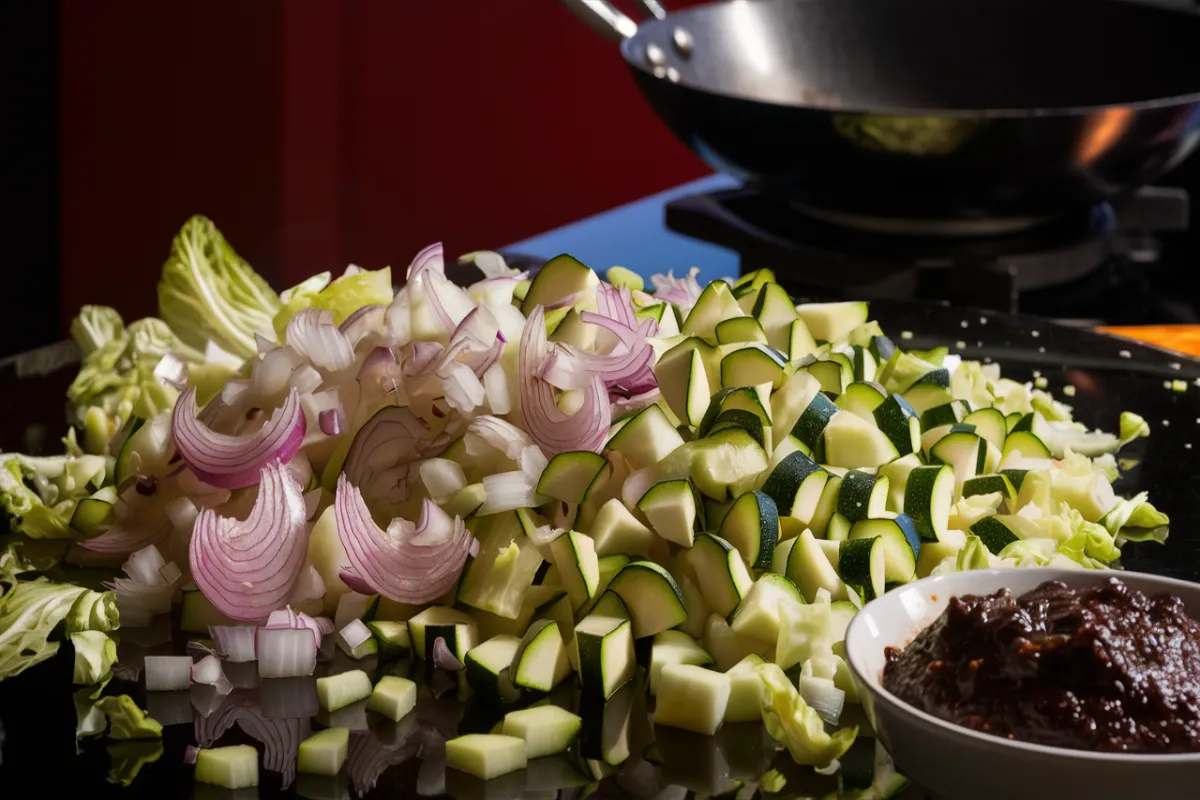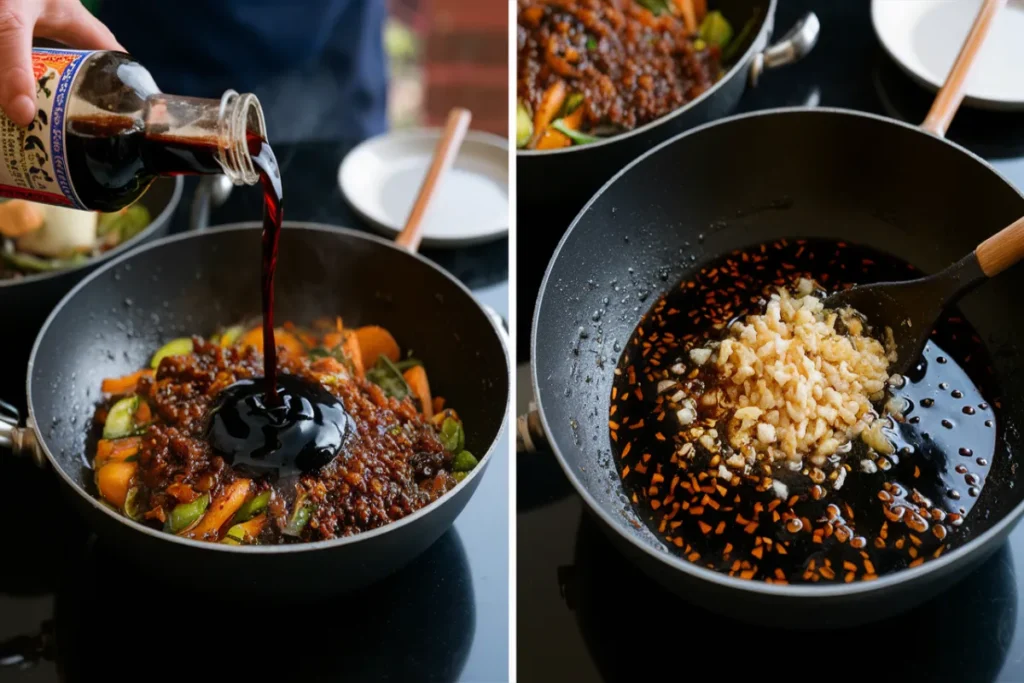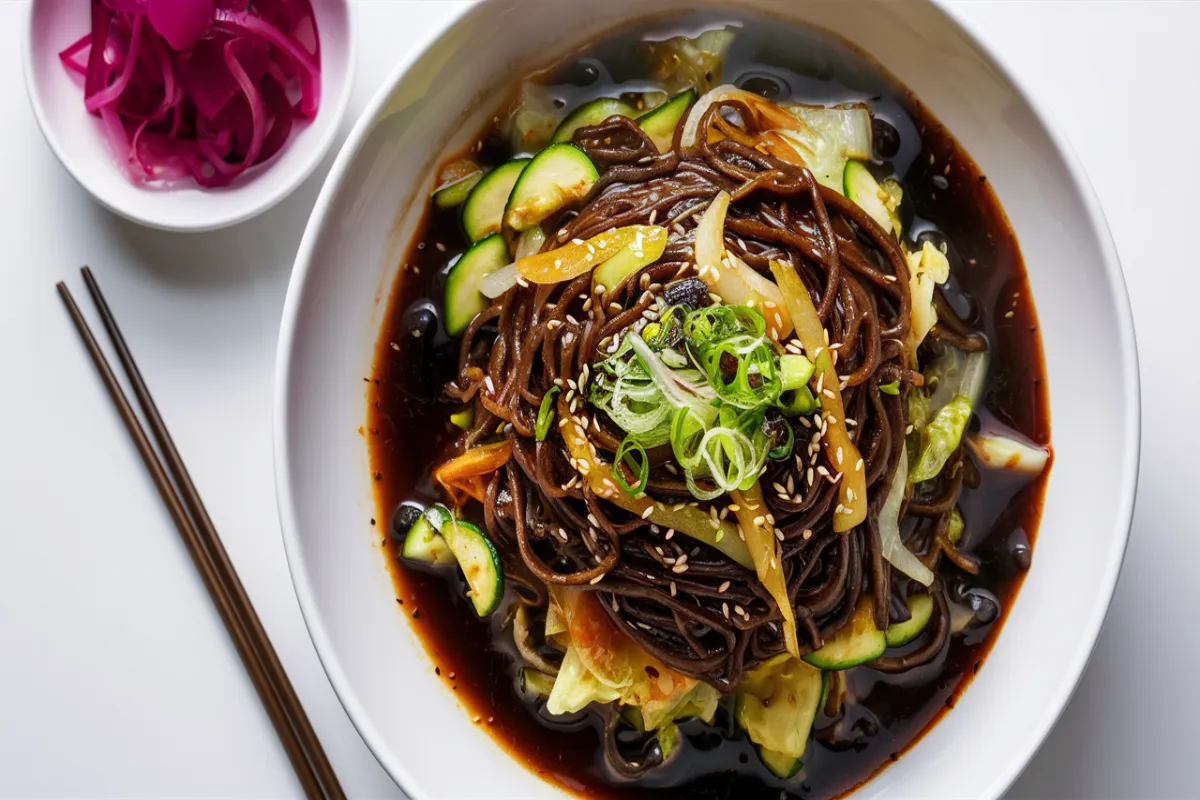Korean black bean noodles, also known as Jajangmyeon, are a savory and delicious dish that offers a unique taste experience. The rich, umami flavor of the black bean paste, combined with the chewy noodles, makes this dish a favorite comfort food. While the dish might look simple, its complex flavor profile comes from the blend of ingredients and cooking methods.
In this article, we’ll explore how black bean noodle tastes like, from the deep umami notes of the black bean paste to the subtle sweetness of the vegetables. Understanding these flavors will help you appreciate the balance in this iconic dish.
1. The Base Flavor: Umami from Black Bean Paste
1.1 What is Black Bean Paste?
The primary flavor of black bean noodles comes from the fermented black bean paste, known as Chunjang. This paste has a deep, earthy flavor, thanks to the fermentation process. When you first taste black bean noodles, the dominant umami flavor hits your palate. The fermentation gives the paste a slightly bitter edge, but this is balanced by the addition of sugar and other ingredients.
Chunjang brings complexity to the dish. As you taste the noodles, you’ll notice a savory richness that coats the mouth, which is characteristic of dishes made with fermented ingredients.
Tip:
When cooking the black bean paste, frying it in oil first helps reduce the bitterness and enhances the umami flavor.
The Power of Fermentation in Skincare
1.2 How the Paste Contributes to the Flavor
After being fried, the black bean paste becomes the backbone of the dish, providing the distinctive black color and deep flavor. The paste’s salty and slightly bitter profile is counterbalanced by other ingredients, creating a complex yet comforting flavor.
The taste of black bean noodles is bold, but not overpowering. The umami element is strong, but as you continue eating, you’ll also pick up on subtle sweet and savory notes that come from the sauce’s other components, such as soy sauce and sugar
2. The Texture of Black Bean Noodles
2.1 Chewy Noodles Complementing the Sauce
The texture of black bean noodles is an essential part of the eating experience. The wheat-based noodles used for Jajangmyeon are thick and chewy. This chewy texture works perfectly with the thick, rich sauce, allowing the noodles to soak up the sauce and carry the bold flavors.
As you chew, the sauce clings to the noodles, ensuring every bite is filled with the black bean flavor. The contrast between the smooth sauce and the chewy noodles provides a satisfying mouthfeel that is one of the highlights of the dish.
Tip:
For the best texture, cook the noodles al dente, ensuring they are firm enough to hold the sauce without becoming mushy.
2.2 Smooth, Thick Sauce
The sauce in black bean noodles is thick and luxurious. Its smooth texture contrasts nicely with the chewy noodles, allowing it to coat each strand evenly. The sauce’s viscosity comes from the cornstarch that is added to thicken it during the cooking process. This thickness ensures the sauce sticks to the noodles rather than pooling at the bottom of the bowl.
As you eat, the sauce remains consistent in texture, making the dish enjoyable from the first bite to the last.
3. Sweetness from Vegetables and Balance of Flavors

3.1 The Role of Vegetables in Black Bean Noodles
Vegetables like onions, zucchini, and cabbage are crucial in balancing the bold, umami flavor of the black bean paste. These vegetables are stir-fried with the paste, providing a slight sweetness that counteracts the bitterness of the fermented beans. The sweetness of the onions, in particular, helps create a balanced flavor profile, making each bite both savory and sweet.
In addition to sweetness, the vegetables also add a crunchy texture that contrasts with the smoothness of the sauce and the chewiness of the noodles.
Tip:
Cut your vegetables into small, uniform pieces so they cook evenly and blend well with the sauce.
3.2 How Sweetness Enhances the Dish
The sweetness from the vegetables helps balance the overall flavor, but the dish is not overly sweet. Instead, the sweetness provides a gentle contrast to the robust black bean paste. As you eat the noodles, the combination of savory and slightly sweet flavors keeps your palate engaged.
Black bean noodles do not rely on sugar for sweetness. Instead, the natural sweetness of the vegetables plays a more significant role, making the dish taste fresh and well-rounded.
4. Umami Boost from Protein
4.1 How Protein Adds Depth
Whether you use pork, beef, or tofu, the protein in black bean noodles plays a key role in adding depth to the flavor. Ground pork is the most traditional protein choice for Jajangmyeon, as it absorbs the sauce well and enhances the umami flavor. As the pork cooks with the black bean paste, it soaks up the sauce, becoming tender and flavorful.
The combination of meat and sauce creates a dish that feels hearty and satisfying. The richness of the meat complements the umami flavor of the paste, making each bite more complex.
Tip:
For a vegetarian option, tofu or mushrooms can replace meat while still adding umami to the dish.
4.2 Tofu as a Vegetarian Alternative
For vegetarians, tofu provides a great alternative to pork. Firm tofu absorbs the sauce just as well, offering a similar mouthfeel without the need for meat. Its mild flavor allows the sauce to shine while still contributing to the dish’s overall texture.
The tofu pieces, when stir-fried with the sauce, develop a slightly crispy exterior that contrasts with the soft interior, making it a delightful addition to the dish.
5. Savory Additions: Soy Sauce and Garlic

5.1 Soy Sauce’s Role in Enhancing Flavor
Soy sauce is another essential ingredient in black bean noodles. While the black bean paste provides the base flavor, soy sauce deepens the savory notes, adding more complexity to the dish. The soy sauce helps to intensify the umami, giving the sauce a salty edge that balances the sweetness from the vegetables.
Even though soy sauce is added in small amounts, its impact on the overall flavor is significant. It enhances the taste of the sauce, making it more rounded and complete.
Tip:
Opt for a high-quality soy sauce to avoid overwhelming the dish with salt.
5.2 Garlic for a Subtle Kick
Garlic is often included in the stir-fry to add a subtle kick to the dish. While it doesn’t dominate the flavor, garlic provides a sharp, aromatic element that enhances the sauce’s depth. As the garlic cooks with the black bean paste and soy sauce, it mellows out, contributing to the dish’s rich flavor without overpowering it.
This hint of garlic adds an extra layer of flavor that makes black bean noodles even more enjoyable.
6. How to Enjoy the Flavor of Black Bean Noodles
6.1 Mixing the Sauce and Noodles
Before eating, it’s customary to mix the sauce thoroughly with the noodles. This ensures that every noodle is evenly coated in the rich sauce, allowing you to taste the full flavor with each bite. The mixing process also helps the sauce cling to the noodles, enhancing the eating experience.
When mixed well, the noodles become infused with the umami, sweet, and savory notes from the sauce, providing a balanced flavor in every mouthful.
Tip:
Add a dash of sesame oil or chili flakes for an extra burst of flavor before mixing.
6.2 Serving with Pickled Radish
Traditionally, black bean noodles are served with a side of pickled yellow radish, known as danmuji. The tartness and crunch of the pickled radish provide a refreshing contrast to the richness of the noodles, helping cleanse the palate between bites. This combination of rich noodles and tangy radish creates a harmonious balance of flavors and textures.
The pickled radish also cuts through the heaviness of the sauce, making the dish feel lighter and more refreshing.
Tip:
For a traditional experience, serve your black bean noodles with a small plate of danmuji and some kimchi.
Frequently Asked Questions (FAQs)
Q1: Do black bean noodles taste bitter?
Black bean noodles may have a slight bitterness due to the fermented black bean paste. However, this is balanced by the sweetness from vegetables and sugar added to the sauce.
Q2: Are black bean noodles sweet?
Black bean noodles have a subtle sweetness, but they are not primarily a sweet dish. The sweetness comes from the stir-fried vegetables, especially onions, and helps balance the savory flavors.
Q3: Can I make black bean noodles without meat?
Yes, black bean noodles can easily be made without meat. Tofu, mushrooms, or tempeh are excellent vegetarian alternatives that still provide a satisfying, umami flavor.
Q4: What makes black bean noodles taste savory?
The savory flavor in black bean noodles comes from the fermented black bean paste and soy sauce, both of which contribute to the dish’s rich umami flavor.
Q5: How should I store leftover black bean noodles?
Store leftover black bean noodles in an airtight container in the refrigerator. To reheat, add a splash of water or broth to loosen the sauce, then warm it on the stovetop or microwave.
Conclusion
Korean black bean noodles offer a complex and balanced flavor profile. The dish combines the deep umami of fermented black bean paste with the slight sweetness of stir-fried vegetables. The chewy noodles, savory meat, or tofu, and thick, flavorful sauce create a comforting yet bold dish that is beloved by many. Whether you’re enjoying it for the first time or making it a staple in your kitchen, understanding how black bean noodles taste allows you to fully appreciate the richness of this classic dish.

